
Iris Agate Gemstone: Properties, Meanings, Value & More
 Iris agate is a mostly ornamental semi-precious gemstone valued by collectors and crystal enthusiasts. In its natural state, iris agate looks like any other ordinary agate stone. Not until you slice into the stone and illuminate it from behind will iris agate’s splendid, lustrous rainbow-like play of colors come to light.
Iris agate is a mostly ornamental semi-precious gemstone valued by collectors and crystal enthusiasts. In its natural state, iris agate looks like any other ordinary agate stone. Not until you slice into the stone and illuminate it from behind will iris agate’s splendid, lustrous rainbow-like play of colors come to light.
In addition to its one-of-a-kind appearance, iris agate is a transformative gemstone with powerful, spellbinding effects. Pretty and transformational? Yes, please!
Are iris agates rare? While it’s a rare variety of agate, it’s quite accessible! (But more on that in a bit).
Were you hoping to elevate your outfit with iris agate? Don’t fret — you can still find some dazzling iris agate jewelry!
What does iris agate do for your wellness? Where can you get it? Keep reading to learn all there is to know about this bewitching mineral in our Iris Agate Gemstone Guide!
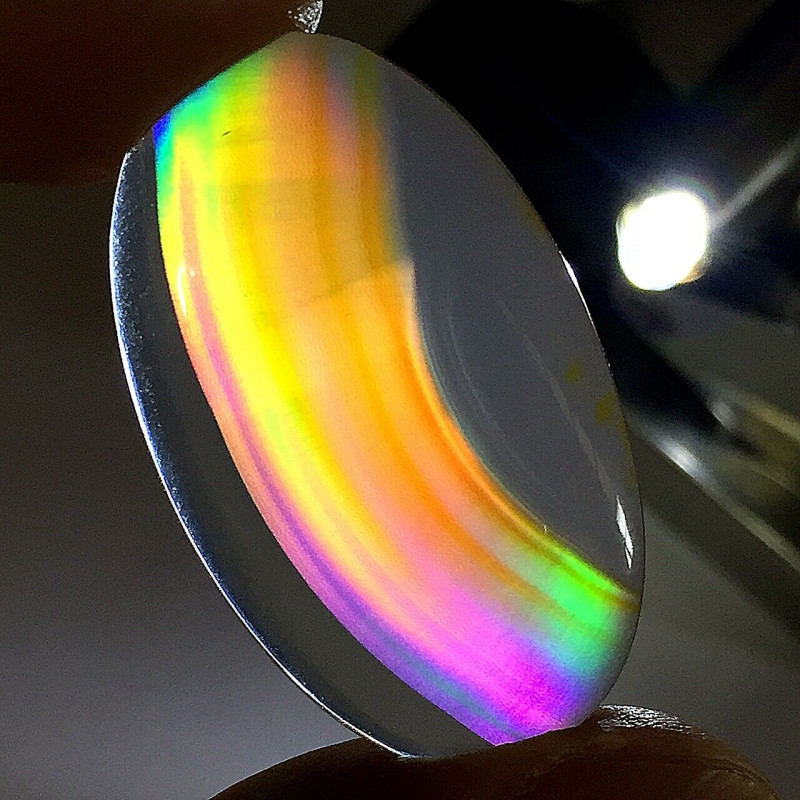
What is Iris Agate?
Iris agate is a finely banded, translucent variety of agate (a subtype of chalcedony) that separates transmitted light into spectral colors. When illuminated, it produces dazzling iridescent bands of all the rainbow colors.
Hence, the name: Iris Agate! In Greek, iris translates to “rainbow” or “rainbow-like appearance.” In Greek mythology, Iris is also a messenger of the gods and the personification of the rainbow.
Other monikers for the stone include Rainbow Agate or Iridescent Agate.
Agate is considered a supportive zodiac stone for the Gemini. It’s believed to help these individuals maintain inner peace and focus.
Moving along, how can you identify iris agate? Understanding its mineral traits helps you know what to look for!
Iris Agate Specifications & Characteristics
As an agate variety, this mineral is a cryptocrystalline type of quartz with its unique features — most notably, its stunning iridescence!
Iris agate owes its holographic spectrum of colors to the presence of a diffraction grating structure. These thin lines alternate between high and low refraction.
The stone's everchanging pattern variations are equally stunning. Each agate stone has an individual pattern based on its original cavity shape and formation. The different alterations are endless, from vibrant to muted, tie-dye to marbled. Usually, the more unique the pattern and color, the more sought-after the gem!
Here’s an overview of iris agate’s mineral data:
Chemical formula: SiO2 (silicon dioxide)
Mineral family: Chalcedony
Composition: Cryptocrystalline quartz
Mohs hardness: 6.5 to 7
Color: Iridescent (displaying luminous, rainbow colors at different angles)
Crystal structure: Trigonal
Luster: Waxy to greasy to vitreous
Transparency: Translucent to opaque
Refractive index: 1.53 to 1.54
Density: 2.55 to 2.70
Birefringence: 0.008 to 0.010
Cleavage: None
Fracture: None
Luminescence: Fluorescent on certain bands
Treatments: Heat treatment and dyeing
Curious about how this colorful gem was discovered? Let’s talk history!
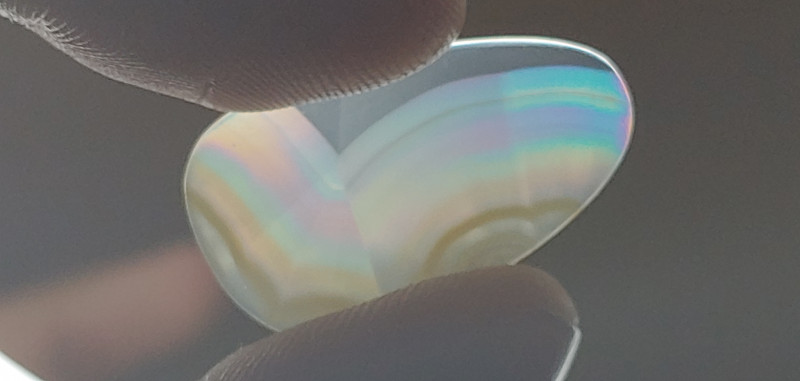
Iris Agate Meaning & History
We know how iris agate got its name, but who found it?
Iris agate was officially discovered in 1933 by Fred S. Young, then publisher of the Oregon Mineralogist. He wrote about finding iris agate in Oregon. Since then, several other localities have been discovered.
The first recorded mention of iris agate dates back to the 4th and 3rd centuries BCE. Theophrastus, a Greek philosopher and naturalist, mentions the mineral in his book, De Lapidibus (Latin for On Stones).
Theophrastus is credited with naming agate after discovering the mineral along the shoreline of the Achates River of Ancient Greece (present-day Fiume Dirillo in Sicily).
Today, iris agate continues to be a popular and favorite stone for modern-day lapidaries, gem collectors, and crystal healers.
Speaking of, let’s explore iris agate’s metaphysical characteristics!

Iris Agate Healing Properties
Most gems are potent healing stones that can support your mind, body, and soul.
In general, agate is considered stabilizing and helpful in reharmonizing the body. Iris agate is considered incredibly transformative, often called a “wish-granting crystal.” Its vivid colors and energy can lift your spirits, ease your physical body, and calm your mind in many ways.
Physical Healing
Physically, what does iris agate do? It’s purported to unravel tension within the body.
Iris agate also holds common agate’s powers; similarly, it can alleviate problems associated with your eyes, stomach, and uterus.
Additionally, the crystal is used to cleanse the lymphatic system and pancreas, help strengthen blood vessels, and soothe skin-related disorders.
Emotional Healing
Regarding emotional healing, iris agate’s tension-relieving energies can help ease stress. It also shifts your perspective to a more positive outlook, allowing you to avoid a narrow viewpoint when handling stressful situations.
If chilling out is on your list of wishes, grab some iris agate and consider it granted.
Spiritual Healing
Into manifestation? Iris agate’s spiritual meaning of granting wishes makes this a powerful stone for manifesting. Simply focus on what you desire most, and iris agate can turn it into a fulfilled reality.
Iris agate also acts as a universal chakra stone, aiding the balance of all seven chakras (or energy points) along your body. By doing so, it clears the way for harmony and energetic balance.
Shifting gears, how is iris agate graded?
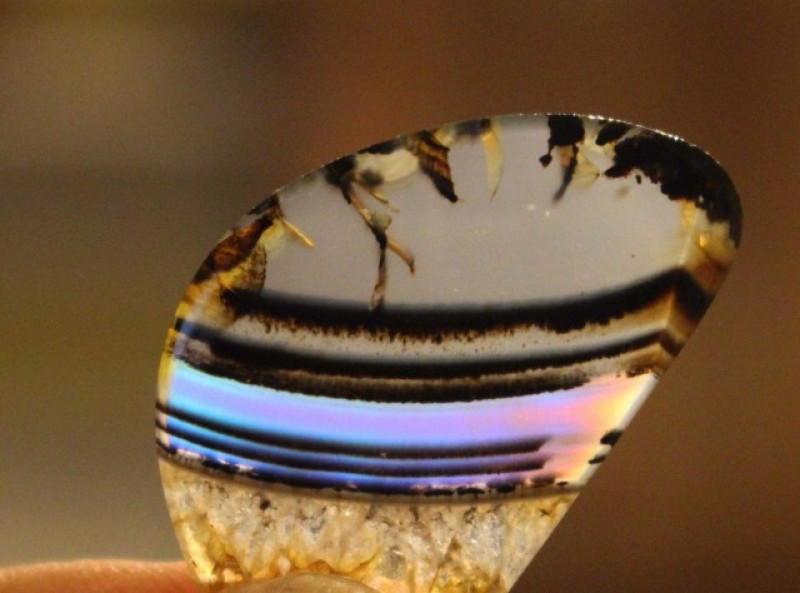
Iris Agate Gemstone Properties
Most iris agate for sale is graded on color, cut, and carat weight. However, iris agate’s distinctive hues are most influential on its value — followed by its cut and size.
Let’s see how each property stacks up.
Color
Since color is arguably the most significant factor in valuing iris agate specimens, the most unique and iridescent ones tend to fetch the highest prices.
Iris agate is most known for its eye-catching color patterns and banding. Under light (artificial or natural), it unveils a striking rainbow fire. Most photos simply don’t do this phenomenon justice.
The mineral’s iridescence results from optical inhomogeneities (imperfections) and transparent impurities embedded inside.
Cut
It’s truly an art form to cut and polish iris agate for emphasizing its iridescence. Collectors and gem enthusiasts invest large amounts in custom cuts and rare varieties.
Rough iris agate is often cut into slices to display its distinct color banding and pattern variations when held up to a light. It’s not as easy as it sounds, though! First, they must be sliced so that the exposed surface is perpendicular to the agate’s banding. The thinner the slice, the stronger the spectral colors.
Afterward, the agate’s surface is typically polished, allowing easy light entry without the scattering caused by an unpolished surface.
Similarly, iris agate cabochons, ornamental carvings, and beads are also popular choices. Faceted cuts and intricate sculptures are rarer but do exist.
Carat Weight & Size
Agates are usually nodular, but masses can be several pounds and many inches in diameter.
Retailers tend to market iris agate in carat weight or grams. However, you may find some sellers that categorize them by length and width rather than mass.
Next, let’s take a peek at how iris agate comes to be and where it comes from!
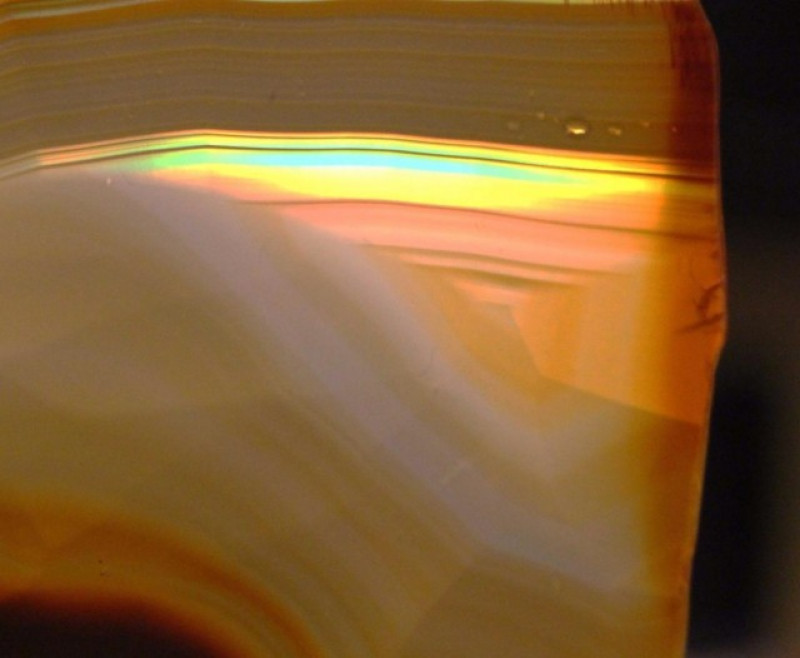
Iris Agate Origin & Sources
Is rainbow iris agate natural? Yes! Its magical transformation from an ordinary agate geode to a polychromatic charmer adds to iris agate’s allure.
So, how does it happen?
Most agate forms via volcanic activity. Air or gas bubbles within cooling magma gradually fill with silica-rich solutions. Eventually, these solutions solidify, forming agates in the shape of “thundereggs” (nodules). Sometimes, they grow inside cracks or layers, creating “vein” or "seam” agates.
Every agate is unique, but all are banded with different patterns and color variations. These variations usually result from impurities present during formation.
Inclusions occur when iron oxide, manganese oxide, or other oxides are present during its formation. These oxides, which are pretty standard, grow and are supported in the agate when it’s in a liquid or gelatinous state.
However, iris agates aren’t a result of inclusions but rather a phenomenon of banding. Their dazzling rainbow effect results from tightly packed, thin layers and banding that can occur in colorless or pale chalcedony.
On that note, where do you find iris agate?
Mining Locations
You can find iris agate in many localities worldwide. In fact, any deposit of agate can contain specimens with the iris structure.
Most commonly, iris agate comes from North and South America. However, other localities include:
Afghanistan
Algeria
Angola
Antarctica
Argentina
Armenia
Australia
Austria
Belgium
Bolivia
Botswana
Brazil
Bulgaria
Canada
Chile
China
Costa Rica
Croatia
Cuba
Czech Republic
DR Congo
Ethiopia
Faroe Islands
Finland
France
Germany
Greece
Hungary
Iceland
India
Indonesia
Iran
Iraq
Isle of Man
Italy
Jamaica
Japan
Kazakhstan
Kenya
Latvia
Lesotho
Madagascar
Malawi
Mexico
Mongolia
Morroco
Mozambique
Namibia
New Zealand
Norway
Panama
Papua New Guinea
Paraguay
Peru
Poland
Portugal
Romania
Russia
Slovakia
South Africa
Spain
Sri Lanka
Sweden
Switzerland
Tajikistan
Turkey
Turkmenistan
United Kingdom
Ukraine
Uruguay
United States
Vietnam
Yemen
Zimbabwe
Phew! That’s a lot of agate!
Rather skip the mining and shop instead? No worries — let’s talk pricing so you can prep your budget!
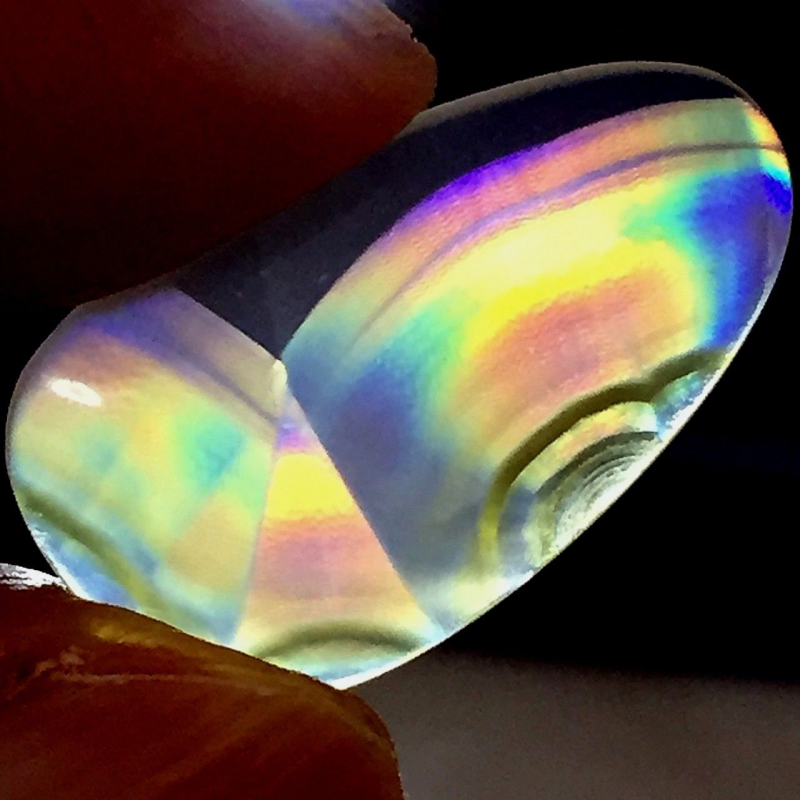
Iris Agate Price & Value
Agates in general are typically quite modestly priced. Their value is more a reflection of labor and artistry rather than grading. Larger pieces with particularly unique color or pattern variations tend to fetch the highest prices.
Mainly, iris agate is sold in its natural state sliced into thin slabs that allow illumination to shine through and highlight its rainbow-like color variations. Rough slices of iris agate generally go for about $7.35 to $11.50 per gram.
Faceted cuts are rare, but they do exist and vary in price. More commonly, iris agate is cut and polished into cabochons costing around $1.65 to $2.80 per carat. Higher quality and rarer specimens are pricier — for instance, $8.20 per carat.
Custom cuts and iris agate carvings garner even higher prices, with some mounted sculptures going for as high as $3000.
Even though it’s relatively durable, iris agate jewelry can be harder to find. This is because the best way to highlight iris agate’s iridescence is by illuminating thin slices of it with light from behind. As a result, iris agate rings aren’t as popular. The same goes for iris agate bracelets.
Instead, you’re more likely to find iris agate in dangling earrings or pendants for necklaces that make it possible for light to shine through one side. Prices generally range between $22 and $62. However, some pieces can cost as low as $12 or as high as $279.
Securing your iris agate is just the first step. Mastering how to care for your gemstones will ensure you get to enjoy their beauty and positive vibrations for years to come!
Iris Agate Care and Maintenance
When it comes to caring for your iris agate, simplicity works best.
Use warm, soapy water and a soft-bristled brush to clean your gems. Avoid ultrasonic, heat, or steam cleaners as these could damage your stones.
For safekeeping, store your iris agate in a compact, fabric-lined box or a soft pouch to keep it from getting scratched or damaged.
Consider opting for iris agate jewelry that uses protective settings to preserve your crystal’s lifetime. Don’t forget to remove your iris agate jewelry before partaking in any rigorous activity like exercising or washing dishes.
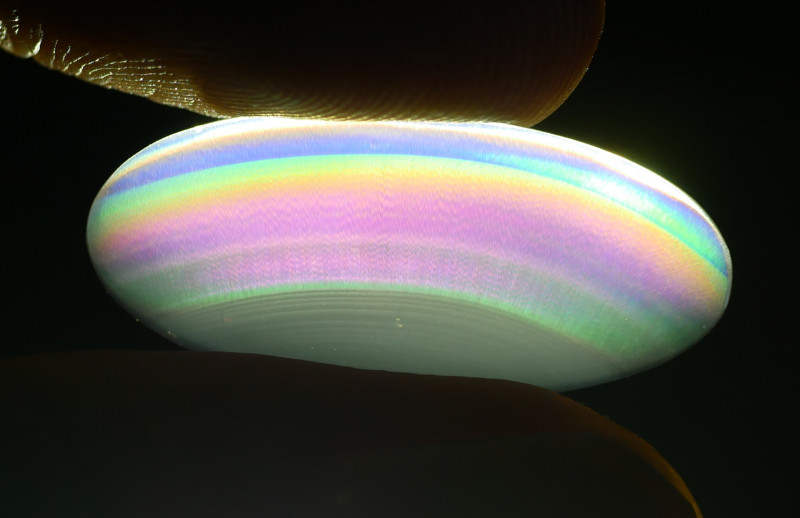
Find Your Rainbow with Iris Agate!
Iris agate is the vibrant, holographic cousin of common agate that steals the show. Its transformative energies may be just what you need to finally step into a new you. Manifest your metamorphosis and make all your wishes come true!
Not into the metaphysical? No sweat. Add some bold, prismatic splendor to your ensemble with iridescent iris agate!
Rainbows and good vibes go with every outfit, right?
Search the Gemstone Encyclopedia
Related Auctions
Related Articles
Originally the Birthstones or gemstones were associated with a zodiac sign or the month of a individuals birth. Find out what your stone is and view the stones we have for sale
8th Feb 2021
There are dozens of quartz and chalcedony gems with various colors and patterns. Learn all about quartz properties and every type of quartz, from amethyst and agate to plasma and phantom quartz!
15th Oct 2020
Hackmanite is a pink to violet sodalite gem known for its unique color-change and luminescence. Learn why hackmanite is special, from its rare qualities to the types of hackmanite jewelry available.
28th Mar 2018
Latest Articles
Kurnakovite is a colorless crystal related to inderite and rarely faceted but known among collectors. Explore the mineral traits, history, prices, and more in this kurnakovite guide.
17th Feb 2025
Prosopite is an uncommon gemstone known for its rare robin’s egg blue form used for cabochons. Discover the history, benefits, prices, and powers of prosopite gemstones!
3rd Feb 2025
Stibiotantalite is a rare tantalum mineral sometimes found as stunning yellow to orange gems. Discover the history, properties, prices, and uses of stibiotantalite gemstones in this complete guide.
21st Jan 2025
Article Categories
How To's is where you will find helpful articles from gem Rock Auctions on how to cut gemstones, select gemstones and buy gemstones.
9 Articles




